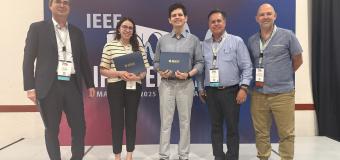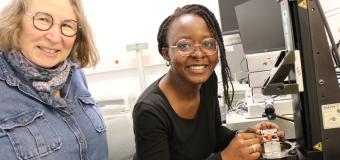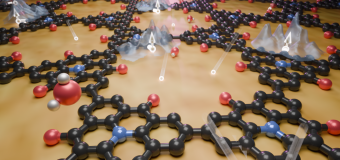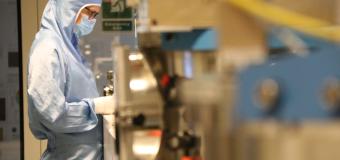Room temperature stable molecules adsorbed on semi-conductors
The adsorption of functional molecules on surfaces plays a vital role in the emerging field of nanoelectronics. In this context, molecular and supramolecular ordering, which are key steps in the development of complexes architectures, are controlled by a balance between intermolecular forces and molecule–substrate interactions.
Isolated molecules on Si(111)-B

Isolated molecules on Si(111)-B
Image 8x12nm2
The deposition of organic molecules and preservation of their entire skeleton, especially on semiconductor surfaces, is still a challenge, although much progress has been made in the development of metallic surface-based devices with organic molecules at low temperature, where the molecule–surface interactions are weak and diffusion remains low. However, the use of metallic substrates is less attractive for potential applications as semiconductors, especially in the field of nanoelectronics.
2D-molecular star on Si(111) 7x7

2D-molecular star on Si(111) 7x7
Image 6x7nm2
In order to circumvent the problem of traditional silicon surface reactivity with pi-conjugated molecules, the Si(111)-B surface is used. This surface has the unique particularity to exhibit depopulated dangling bonds due to the presence of boron atoms under the top silicon layer. We have shown that the weak interactions between rich pi-electron molecules with empty pz depopulated dangling orbitals of the Si-B surface are most likely to be at the origin of the specific adsorption of isolated triazine molecules at the Si-B surface. This structure is stable at room temperature, and the pi-conjugated skeleton of organic molecules is preserved even after deposition [1].
We propose a new concept for the room-temperature deposition of pi-conjugated organic molecules, without any modification of their electronic structure, at specific adsorption sites on the surface of the semiconductor Si(111)-7x7 by adsorbing p-conjugated zwitterionic molecules on this semiconductor surface. The presence of a negative charge on the target molecules offsets the electrophilic character of the Si(111)-7x7 adatoms and preserves the p skeleton of the organic molecules after deposition. The half-cells of Si(111)-7x7 act as a template that guides the molecular assembly of achiral molecules, as shown by the induction of chirality in the modified areas [2].
The results reported herein are remarkable from several different points of view, especially the molecular assembly at room temperature, the chirality of the assembly, and the stability and conservation of the pi-conjugated skeleton on the semiconductor surface at room temperature. These strategies may become important methods for the deposition of pi-conjugated molecules.
Contact: frank.palmino@pu-pm.univ-fcomte.fr
The Nanosciences group are: Y. Makoudi (PhD), Dr F. Palmino, Dr E. Duverger, Dr F. Chérioux.
[1] Y. Makoudi, M. Arab, F. Palmino, E. Duverger, F. Chérioux, C. Ramseyer, M. J.-L. Tschan, B. Therrien, G. Süss-Fink, Phys. Rev. Lett., sous presse, parution Février 2008.
[2] Y. Makoudi, M. Arab, F. Palmino, E. Duverger, C. Ramseyer, F. Picaud, F. Chérioux, Angew. Chem. Int. Ed., 2007, 46, 9287-9290.



















